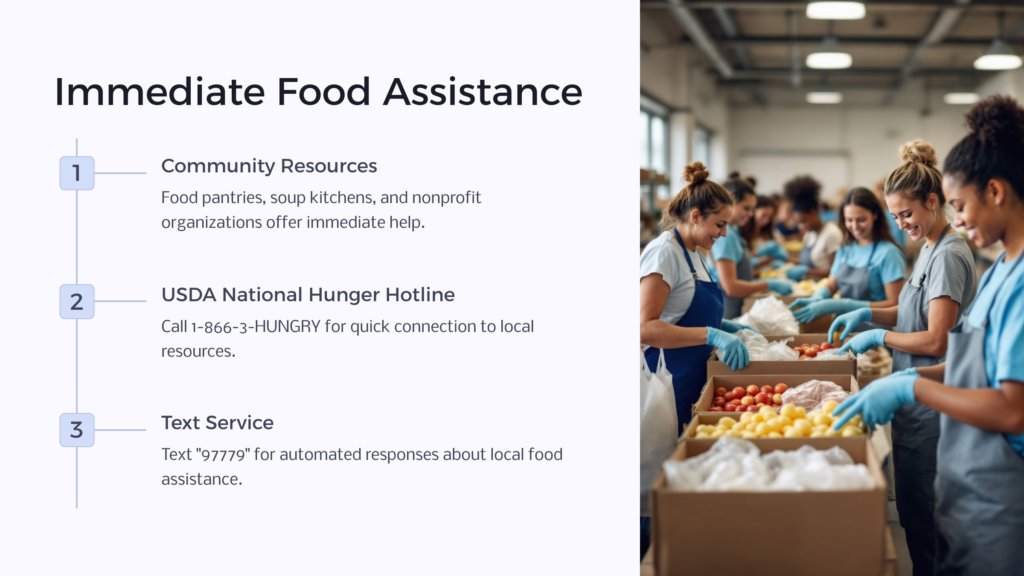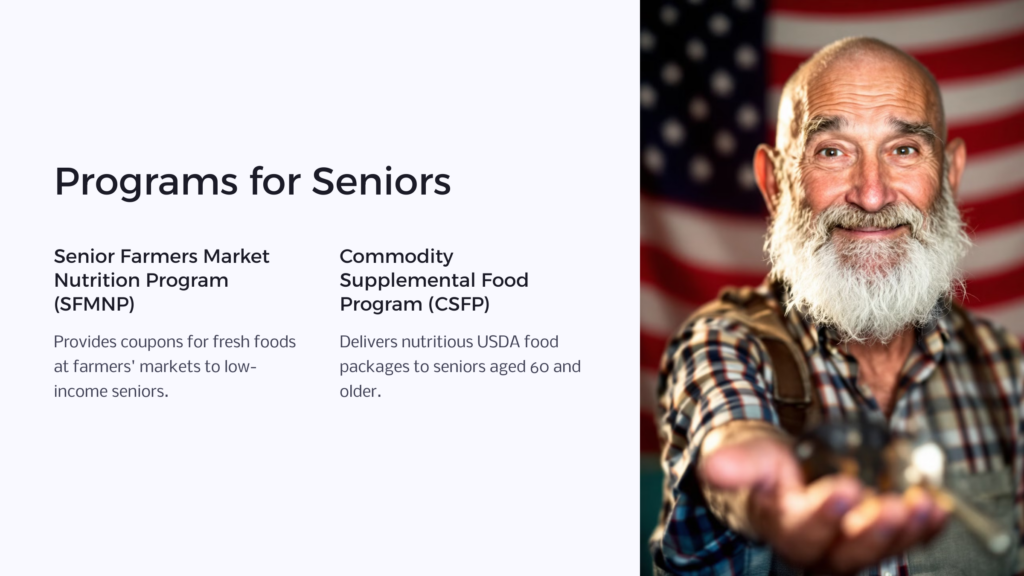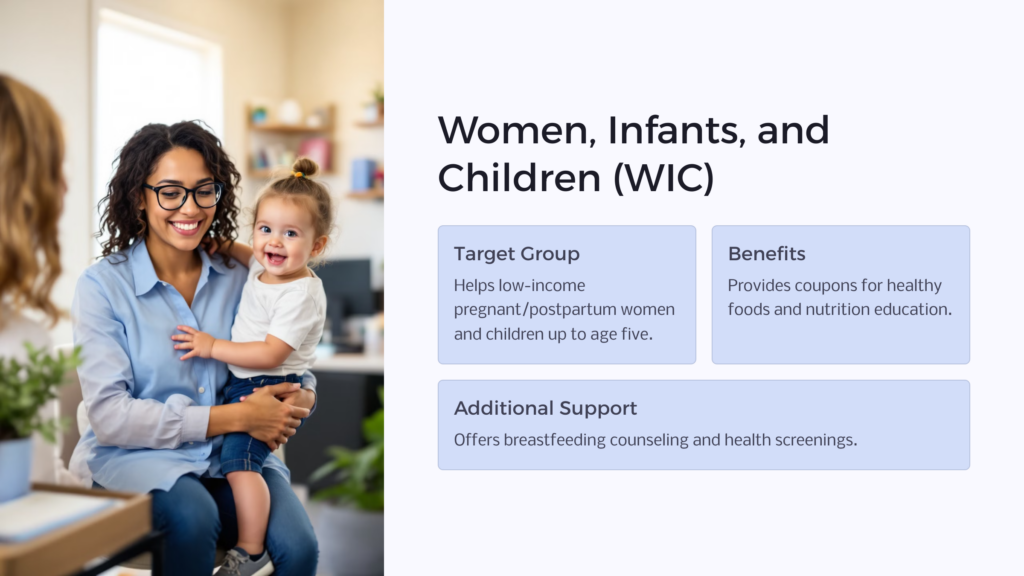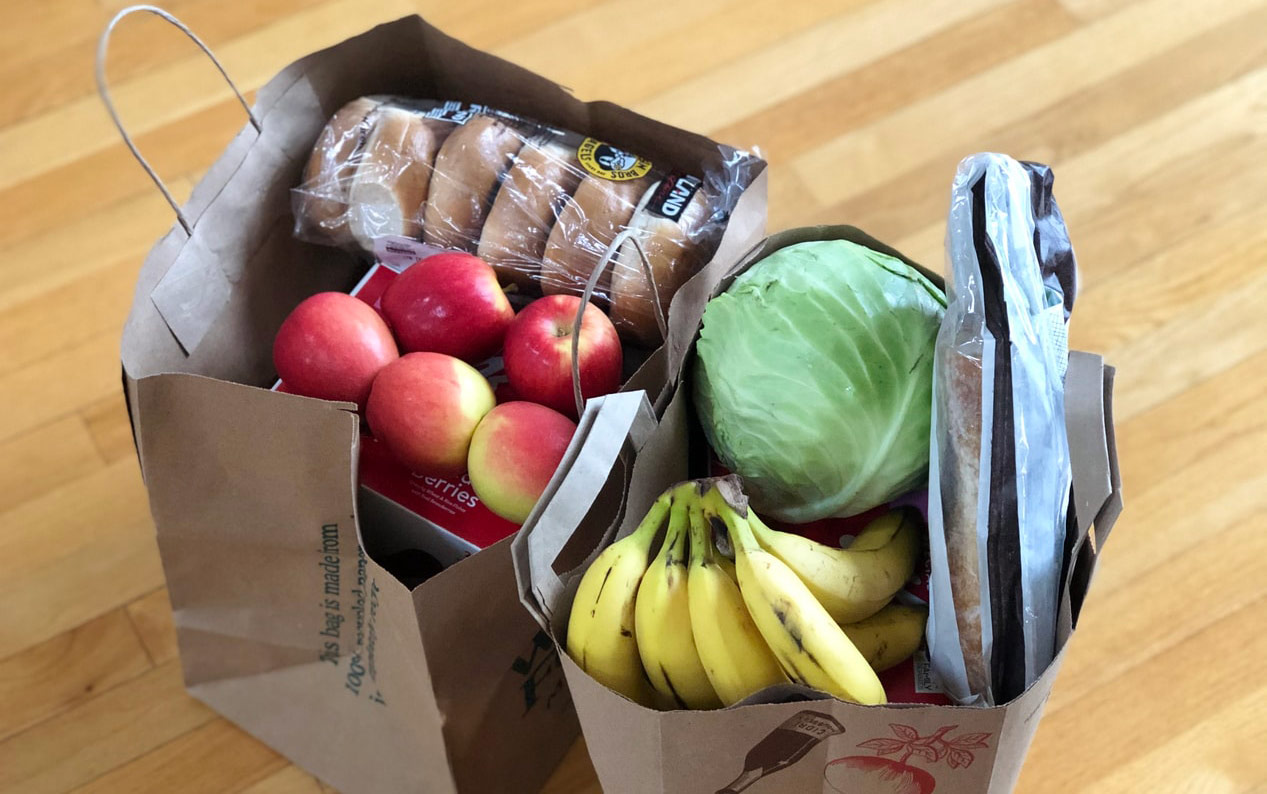Federal food assistance programs exist to help low-income individuals and families who are experiencing difficulties buying food. Each program serves a different purpose. Some programs target specific groups, like seniors, pregnant and nursing women and their young children, and school students.
12 Food Assistance Programs
- Supplemental Nutrition Assistance Program (SNAP)
- Immediate Food Assistance
- Senior Farmers Market Nutrition Program (SFMNP)
- Commodity Supplemental Food Program (CSFP)
- National School Lunch Program (NSLP)
- Child and Adult Care Food Program (CACFP)
- School Breakfast Program (SBP)
- Special Supplemental Nutrition Program for Women, Infants, and Children (WIC)
- Farmers to Families
- The Emergency Food Assistance Program (TEFAP)
- Food Distribution Program on Indian Reservations (FDPIR)
- Disaster Supplemental Nutrition Assistance Program (D-SNAP)
Food assistance is available from the government for eligible individuals and families. The food assistance programs listed above include well-known options to help people get the food they need. Each program operates a bit differently, with some offering each household a monthly benefit of cash to buy food, while other programs provide nutritious meals.
Several non-federal programs can also help you get the food you need, such as local food pantries, soup kitchens, and even animal organizations that get you the pet food you need for your cat or dog. Churches, nonprofits, and local organizations usually offer these programs, so it’s a good idea to check your community resources in addition to federal programs if you’re in need.
12 Food Assistance Programs
The following food assistance programs are ones to consider if you need help buying food. Check each program’s eligibility guidelines to determine if you may receive benefits based on your demographics, income, household size, nutrition needs, and other criteria.
1. Supplemental Nutrition Assistance Program (SNAP)

SNAP is one of the most well-known food assistance programs and one of the largest, serving about 42 million people annually. The program used to be called the Food Stamps Program, and many people still refer to it as such.
Food stamp benefits give those who qualify for food stamps a monthly allowance to buy food and drinks that fit within the guidelines of the program. SNAP recipients use an EBT card that works like a debit card.
2. Immediate Food Assistance

Individuals or households who have lost their income or experienced a disaster may qualify for immediate emergency food assistance without signing up for a program. Immediate food assistance is often available through community-based programs, like food pantries, soup kitchens, and nonprofit organizations.
You may also contact the USDA National Hunger Hotline at 1-866-3-HUNGRY. This hotline helps people in emergencies find food they need for themselves and their families. They can quickly connect you to local resources. You can also send a text to “97779” to ask a question about local food assistance and receive an automated response.
There are also emergency food assistance programs in place to assist individuals and families who have been impacted by the COVID 19 pandemic.
You can learn more about available programs and resources from the Centers for Disease Control and Prevention (CDC), including pandemic EBT (P-EBT) benefits, food bank options, and nutritious food supplementation.
3. Senior Farmers Market Nutrition Program (SFMNP)

Low-income seniors can take part in SFMNP, which allows them to get coupons to buy fresh foods at farmers’ markets and community agriculture programs. Eligible seniors can use their coupons for fruits, herbs, vegetables, and honey. Seniors may be eligible for the program if they’re at least 60 years old and have an income of no more than 185% of the federal poverty guidelines.
This program has two significant benefits. First, it provides seniors with nutrition assistance by providing nutritious, locally-grown foods while encouraging them to stock up on healthy food. Second, it supports farmers’ markets and other agricultural resources by stimulating their sales.
4. Commodity Supplemental Food Program (CSFP)
CSFP is another program that supports the health of seniors by assisting them in getting nutritious food backed by the U.S. Department of Agriculture (USDA). This program is for seniors age 60 and older who live in an eligible state or Indian reservation. Some states require those in the program to have a nutritional risk supported by a medical evaluation.
The primary focus of this program is to deliver packages of nutritious USDA food to seniors to supplement their diet and assist them with nutrition education to help them eat better. CSFP distributes food to participating states, which will then pass along the food packages to seniors who participate in their programs.
5. National School Lunch Program (NSLP)
The NSLP is part of the National School Lunch Act of 1946. It helps children of low-income families get access to free or reduced-price lunches when they’re a student at a public or nonprofit private school. Low-income households may apply for the program through their school district each year to determine eligibility for the upcoming school year. Depending on household income, students receive either reduced prices or free lunches.
The number of children who participate in the NSLP has significantly increased since the program started. In 2016, more than 30 million children received free or discounted lunches through the NSLP.
6. Child and Adult Care Food Program (CACFP)
CACFP reimburses child care centers and adult daycare centers for funds used to provide eligible children and adults with nutritious meals while at the center. Public and nonprofit private centers are eligible to participate in CACFP. Along with sending funds to centers to purchase meals, CACFP sets nutrition standards that centers must follow to ensure the children and adults they care for receive wholesome, nutritious meals.
Meal standards under CACFP align closely with the Dietary Guidelines for Americans. The following guidelines are included in the program:
- Reduce sugar by aligning with specific sugar limits in a serving of food
- Increase whole grains by offering whole grain-rich or enriched foods
- Infants must have iron-fortified infant cereal and formula
- Each child or adult meal must include grains, fruits/vegetables, meat/protein, and milk
7. School Breakfast Program (SBP)
SBP is a federal program that grants funds to states, which then disperse those funds to local school districts. Districts are then responsible for running the program within their schools to serve students a nutritious breakfast. The idea behind the program is to help students eat breakfast in the morning so they can be more alert and productive throughout the day. The program also seeks to boost nutrition in students.
SBP is available in nonprofit private schools, public schools, and residential child care facilities. States may handle this program a bit differently. Some states may give free or discounted breakfasts to children who qualify by income. Others might distribute enough funds to districts with low-income households to give students access to free breakfast.
8. Special Supplemental Nutrition Program for Women, Infants, and Children (WIC)

WIC is funded by the USDA. The program helps women and young children receive nutritious supplemental food for free. Beginning 1974, the program is available to low-income households that include a pregnant or postpartum woman and an infant or child up to age five.

WIC gives families coupons for purchasing healthy foods like cheese, peanut butter, milk, and infant formula. Families on WIC must participate in regular appointments to check their nutrition and health. The women also receive nutrition education to help them plan and consume healthy meals and snacks. WIC can connect an eligible household with community resources, like breastfeeding counseling and health screenings, to support their overall health and well-being.
9. Farmers to Families
Farmers to Families is a program started in response to the Coronavirus pandemic to help both families in need and struggling farmers continue to thrive. Although the program was originally set to end on December 31st, 2020, it received additional funding to continue through April 2021.
The program buys dairy, meat, and produce from American farmers and food producers to stimulate their businesses. The items get packaged into boxes for families to receive at food pantries and other community resources that assist people in need.
Although Farmers to Families is available in all states, each state allocates its funds separately. Therefore, some states may run out of food boxes more quickly than others.
10. The Emergency Food Assistance Program (TEFAP)
The Emergency Food Assistance Program is another USDA-supported food program that helps needy families and individuals receive nutritious foods. TEFAP food options are USDA foods from the American agricultural market and may include milk, meat, fruits, vegetables, and whole-grain pasta.
Organizations that provide food to people and need can receive TEFAP assistance, as can eligible households directly. States set individual income guidelines individuals and families must meet to be eligible for TEFAP.
11. Food Distribution Program on Indian Reservations (FDPIR)
FDPIR is a food program designed specifically for Native Americans living on Indian reservations. In some states, you Native American can live near a reservation. Oklahoma allows FDPIR recipients to live anywhere in the state. Participants must also be income-eligible as determined by program guidelines. This program is often used as an alternative to SNAP benefits for eligible individuals and families who can’t easily access the SNAP program because the SNAP office is too far away.
With FDPIR, participants receive food packages that may include flour, cereal, spaghetti sauce, fruits, vegetables, meat, dairy products, and other foods and ingredients. The USDA provides a list of eligible foods that participants may choose from.
12. Disaster Supplemental Nutrition Assistance Program (D-SNAP)
Individuals or families who have experienced a natural disaster may be eligible for D-SNAP. Despite its name, D-SNAP does not follow the same eligibility process as SNAP. Instead, your area must have been declared a disaster area with Individual Assistance benefits and you must have a noted disaster-related expense.
States handle the distribution of benefits differently, but many states deposit money to an EBT card that you can use like a debit card to purchase approved food items. In most cases, the benefits on the card will expire if you don’t use them within a specific amount of time.
Get Help from Federal Food Assistance Programs
No one should suffer from hunger or food insecurity, which is why the government has these beneficial programs in place. It’s important to read through the information for each program to decide if it’s right for you and your family.
You can inquire about federal food assistance programs by checking with your local human services department. They will determine your eligibility and help you find the right program so you and your family can eat healthy food.
 Benefits.com Advisors
Benefits.com Advisors
With expertise spanning local, state, and federal benefit programs, our team is dedicated to guiding individuals towards the perfect program tailored to their unique circumstances.
Rise to the top with Peak Benefits!
Join our Peak Benefits Newsletter for the latest news, resources, and offers on all things government benefits.



















